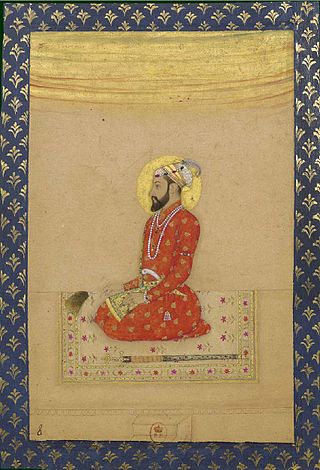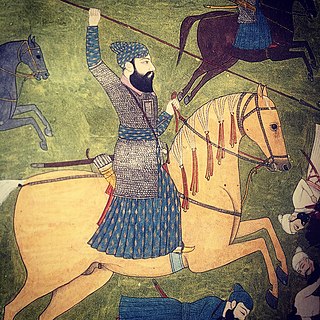
Mirza Mu'izz-ud-Din Beg Muhammad Khan, more commonly known as Jahandar Shah, was the ninth Mughal Emperor who ruled for a brief period in 1712–1713. He was the son of Bahadur Shah, and the grandson of Alamgir (Aurangzeb). Jahandar Shah was the first puppet ruler of the Mughal dynasty, having been placed on the throne by powerful noble Zulfiqar Khan. His reign was short and turbulent, lasting less than a year. He was deposed and succeeded by his nephew Farrukhsiyar with the backing of the Sayyid brothers in 1713.

Bahadur Shah I, also known as Mirza Muhammad Mu'azzam and Shah Alam I was the eighth Mughal Emperor who ruled from 1707 until his death in 1712. He was the second son of Mughal emperor Aurangzeb, who he conspired to overthrow in his youth. He was also governor of Agra, Kabul and Lahore and had to face revolts of Rajputs and Sikhs.

Mughal emperors were the supreme heads of state of the Mughal Empire on the Indian subcontinent, mainly corresponding to the modern countries of India, Pakistan, Afghanistan and Bangladesh. The Mughal rulers styled themselves as Badshah or Shahanshah, a title usually translated from Persian as "emperor". They began to rule parts of India from 1526, and by 1707 ruled most of the sub-continent. After that they declined rapidly, but nominally ruled territories until the Indian Rebellion of 1857.

Farrukhsiyar or Farrukh Siyar was the tenth emperor of the Mughal Empire from 1713 to 1719. He rose to the throne after assassinating his uncle, Emperor Jahandar Shah. Reportedly a handsome man who was easily swayed by his advisers, he lacked the ability, knowledge and character to rule independently. He was an emperor only in name, with all effective power in the hands of the Sayyids of Barah. Farrukhsiyar was the son of Azim-ush-Shan and Sahiba Niswan.

Mirza Muhammad Murad Bakhsh, (9 October 1624 – 14 December 1661) was a Mughal prince and the youngest surviving son of Mughal Emperor Shah Jahan and Empress Mumtaz Mahal. He was the Subahdar of Balkh, till he was replaced by his elder brother Aurangzeb in the year 1647.

Ahmad Shah Bahadur, also known as Mirza Ahmad Shah or Mujahid-ud-Din Ahmad Shah Ghazi, was the fourteenth Mughal Emperor, born to Emperor Muhammad Shah. He succeeded his father to the throne in 1748, at the age of 22. When Ahmed Shah Bahadur came to power, the Mughal Empire was collapsing. Furthermore, his administrative weakness eventually led to the rise of the usurping Imad-ul-Mulk.

Ajit Singh Rathore was the ruler of Marwar region in the present-day Rajasthan and the son of Jaswant Singh Rathore.
Meo, is an ethnic group of the Mewat region from north-western India, particularly from the Nuh district in Haryana and parts of adjacent Alwar and Bharatpur districts in Rajasthan. They speak Mewati, a language of the Indo-Aryan language family, although in some areas the language dominance of Urdu and Hindi has seen Meos adopt these languages instead.

Battle of Samugarh, Jang-e-Samugarh,, was a decisive battle in the struggle for the throne during the Mughal war of succession (1658–1659) between the sons of Mughal Emperor Shah Jahan after the emperor's serious illness in September 1657. The battle of Samugarh was fought between Dara Shikoh and his three younger brothers Aurangzeb,Shah Shuja and Murad Baksh to decide who would be the heir of the throne after their father.

Banda Singh Bahadur, was a Sikh warrior and a commander of the Khalsa army. At age 15, he left home to become an ascetic, and was given the name Madho Das Bairagi. He established a monastery at Nānded, on the bank of the river Godāvarī. In 1707, Guru Gobind Singh accepted an invitation to meet Bahadur Shah I in southern India, he visited Banda Singh Bahadur in 1708. Banda became disciple of Guru Gobind Singh and was given a new name, Gurbaksh Singh(as written in Mahan Kosh), after the baptism ceremony. He is popularly known as Banda Singh Bahadur. He was given five arrows by the Guru as a blessing for the battles ahead. He came to Khanda, Sonipat and assembled a fighting force and led the struggle against the Mughal Empire.
Lohgarh is a historic town in Bilaspur tehsil of Yamunanagar district of Haryana in India. It was the capital of the Sikh state under Baba Banda Singh Bahadur from 1710 to 1716.
The Battle of Jajau was fought between the two Mughal princes and brothers Bahadur Shah I and Muhammad Azam Shah on 20 June 1707. In 1707, their father Aurangzeb died without having declared a successor; instead leaving a will in which he instructed his sons to divide the empire between themselves. Their failure to reach a satisfactory agreement led to a military conflict. After Azam Shah and his three sons were killed in the Battle of Jajau, Bahadur Shah I was crowned as the Mughal emperor on 19 June 1707 at the age of 63.
The Battle of Lohgarh was a battle fought between the Sikhs, led by Banda Singh Bahadur, and the Mughal Empire in 1710. The Mughal emperor Bahadur Shah's army moved towards Lohgarh where they engaged with the Sikhs to capture the fort on 16 December 1710. The battle is noted for its use of guerilla tactics and being a pitched battle.

Ahmad Shah Durrani invaded the Indian subcontinent from the northwest eight times between 1748 and 1767. After the assassination of Nadir Shah, Ahmad Shah Durrani succeeded the throne of Afghanistan and started plundering wealth from nearby regions. His repeated incursions brought the Mughal empire to the brink of collapse and further dealt a major blow to Maratha dominions in the North at Panipat, creating a power vacuum. His objectives were met through the raids and caused political issues in India.
The Battle of Manupur was fought between the Mughal Empire and the Durrani Empire in March 1748 near Sirhind which ended in victory for the Mughals.
The Khanzadas of Mewat were a dynasty of chiefs from Rajputana who had their capital at Alwar. The Khanzadas were Muslim Rajputs who descended from Raja Sonpar Pal who was a Yaduvanshi Rajput who converted to Islam during the period of the Delhi Sultanate in India.

The Rajput rebellion began in 1708, due to the harsh treatment of the Rajput Rajas by the Mughal emperor. It erupted into a two-year rebellion that forced the Mughal emperor to sue for peace, give them gifts, and restore the Rajput holdings which had been annexed by the previous Mughal emperor Aurangzeb.
The Battle of Hoshiarpur was one of several battles fought in the Mughal-Sikh wars. Isa Khan, a Mughal zamindar of the Lakhi Jungle in Punjab, attacked the Sikhs at Hoshiarpur. After his victory, he was awarded with the Faujdarship of the Jalandhar doab.
Jalal Khan Rohilla was an inhabitant of Muzaffarnagar in the Mughal era during the reign of Farrukhsiyar. He is known for founding the village of Jalalabad, Shamli after himself.










